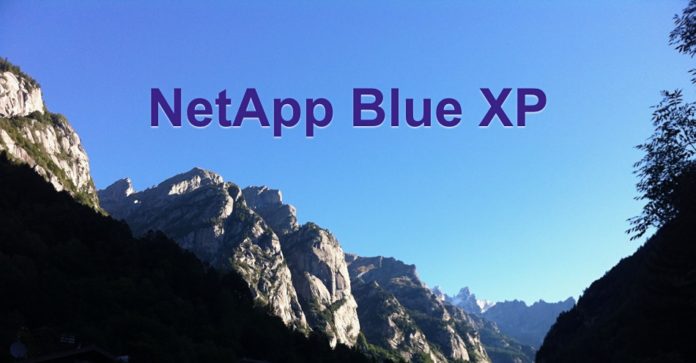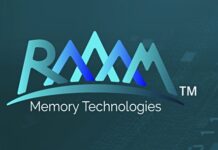NetApp is announcing the availability of Blue XP, a software control plane to manage a customer’s data estate in a hybrid on-premises and multi-cloud environment with extensibility beyond NetApp tech.
NetApp CEO George Kurian’s Insight 2022 pitch spoke about the evolved cloud idea “where cloud is fully integrated into your architecture and operations and not just another silo walled garden.
“A true evolved cloud solution has common data management capabilities at the storage infrastructure layer, common infrastructure management capabilities, common API’s and open source databases, data pipelines, and workflows for stateful applications.”
Blue XP is the common data management capability. It is a single, unified NetApp control plane for a data estate in a hybrid multi-cloud environment, consumed as SaaS. Blue XP has deployment, management, observability, security and consumption of data and application services, and operates in an open architecture.

Blue XP has an AIOps-driven experience. NetApp says it allows users to manage their broad data estate, including on-premises unified storage and first-party native storage with public cloud providers. It’s not aimed at managing data on IBM mainframes, Apple iPads etc. being focused on data stored in common enterprise NFS/SMB, block, and object data stores across the Windows/Linux spectrum and the workloads found there.
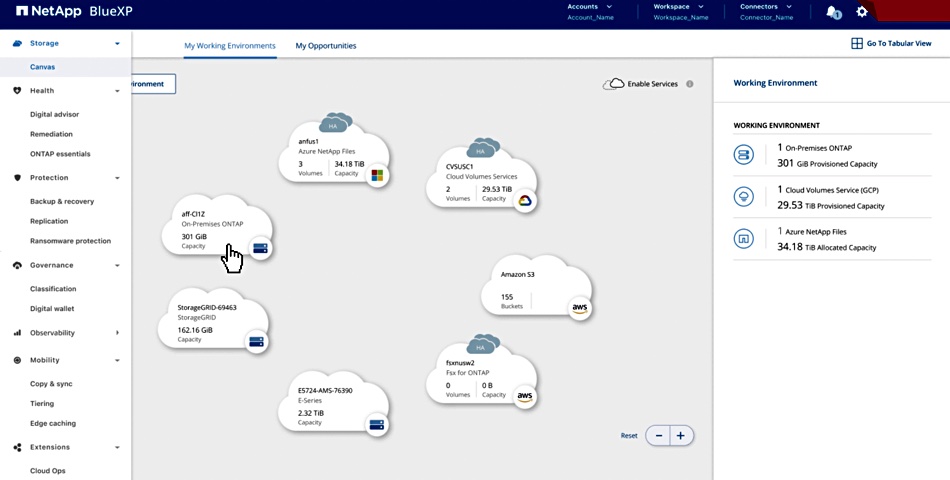
BlueXP provides a range of services across file systems, object stores, SAN environments, virtual machine instances, and Kubernetes clusters, as well as database instances including SQL, Oracle, SAP/HANA, Jenkins, MongoDB, and others. The services include:
- Unified Storage Management: Ability to manage NetApp AFF, FAS, StorageGRID, and E-Series on-premises storage, Amazon FSx for NetApp ONTAP, Azure NetApp Files, Google Cloud Volumes Service, and Cloud Volumes ONTAP in a single console.
- AIOps-Driven Health: BlueXP integrates NetApp’s Active IQ technology for always-on telemetry with AI-enabled health and status monitoring to detect and alert infrastructure and workload issues, and offer proactive guidance.
- Cyber-Resilience: Unified control of data protection and security with an integrated zero-trust model and a single ransomware dashboard for company-wide visibility into ransomware vulnerabilities with the ability to fix many issues automatically with a single click.
- Governance: A complete view of the Blue XP-managed digital estate to monitor compliance and permissions, detecting anomalies, and taking prescribed actions.
- Mobility: Integrated data movers allow for copying, syncing, tiering, and caching data across all major clouds and the datacenter, with data protected in transit and stored on the lowest-cost storage tier possible.
- Usage Billing: Customers are billed on usage. A Digital Wallet allows for licenses for data services to be interchanged as needs change. NetApp’s Keystone Storage-as-a-Service (STaaS) offering is integrated so customers can manage their consumption-based datacenter storage alongside their cloud storage.
Ransomware dashboard
A single BlueXP ransomware dashboard provides company-wide visibility into ransomware vulnerabilities. NetApp’s Cloud Data Sense service is integrated into Blue XP enabling it to scan data across multiple repositories as well as NetApp stores. It can scan into various third-party products, including AWS S3, Azure Blob, Google Drive, SharePoint Online, OneDrive, Oracle SAP HANA, and many more.
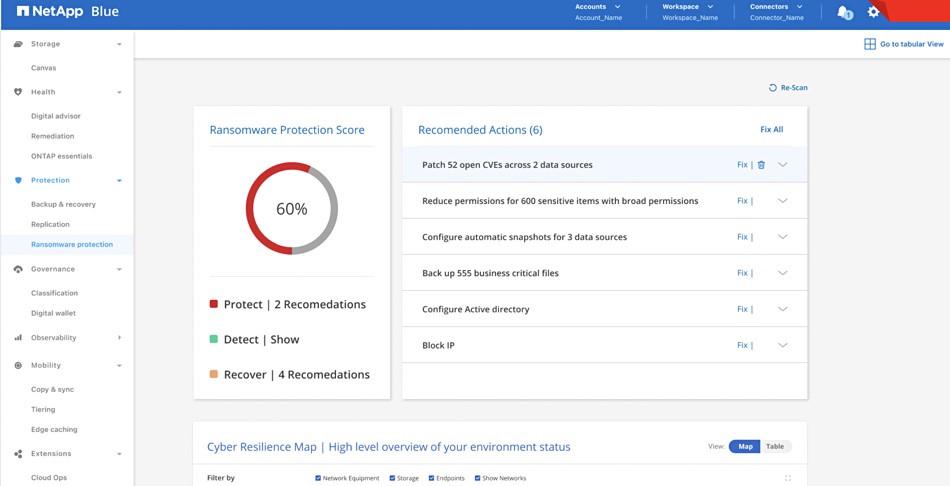
ONTAP’s built-in anti-ransomware detection capabilities can populate this ransomware protection dashboard and provide a ransomware protection score. Vulnerabilities can be exposed and reported to third-party vendors, such as a wide range of permissions being exposed or noticeably higher rates of encryption occurring.
Blue XP is available in disconnected mode. Ronen Schwartz, NetApp’s SVP and GM of cloud storage, told us: “Customers [like] three letter agencies in certain government branches, etc they need to be in disconnected mode. They can run Blue XP inside their VPC without any external connection.”
Future potential
We asked Schwartz if NetApp was thinking about partnerships with third-party data protection providers so that the status of their activities could be surfaced in the Blue XP dashboard.
He said: “This is a very big step forward. It’s a very exciting, but you’re calling out the potential, which is … absolutely right. And it goes to data protection vendors, it will go to catalog and scanning privacy technologies, everything that has to do with data, this is a very good place for vendors to surface their value.”
Broader observability is another aspect of potential third-party integration. How about adding automated decision-making?
Schwartz said: “The goal is to be fully autonomous.”
We understand that this could apply to ransomware and to data protection generally. There is a significant ONTAP engineering project around adding autonomy to the OS.
Blue XP and Spot
NetApp has made a group of acquisitions to build a CloudOps service set – CloudJumper, Spot, Cloud Insights, CloudHawk, Data Mechanics, CloudCheckr, Filament, and InstaCluster. It is building a Spot by NetApp portfolio for CloudOps, a CloudOps control plane that complements the Blue XP control plane. The company will integrate its complete CloudOps portfolio into a unified Spot console, as well as harmonizing back-end services and APIs across BlueXP and Spot in areas such as authentication, billing, tenancy, and more.
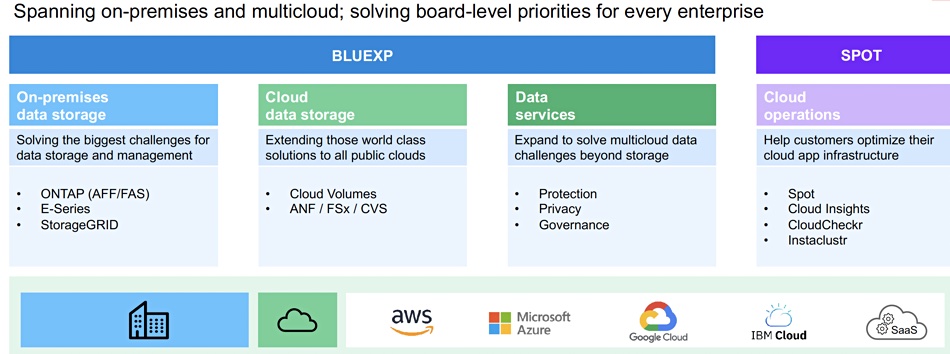
The Spot CloudOps suite will be available next month with three service groups:
- Application services: Fully managed services for deployment, databases, data processing, and productivity
- Infrastructure optimization: Automated and continuous based on telemetry and predictive analysis applying to containers, compute, networking, storage, observability, and connections
- Operations Automation: Data-driven automation of scaling, monitoring, governance across deployments, teams, and clouds
ONTAP update
ONTAP, NetApp’s AFF and FAS array OS, has been updated to v9.12.1 and its added features include:

NetApp is also introducing what it terms as a storage efficiency guarantee. Kurian’s Insight presentation script says that this is “a 4-to-1 storage efficiency guarantee for SAN workloads on all of our ONTAP all-flash systems, including AFF … and even FAS500f.”
“With our 4-to-1 efficiency guarantee and our cloud tiering, which typically sees 60 percent or more of data being tiered to the public cloud, this means you could use up to 80 percent less on-premises storage with NetApp than you would with a typical competitive storage array.”
A green sustainability blanket is laid over this: “If you were to replace 80 percent of the on-premises storage shipped by a competitor this year with NetApp using our 4-to-1 efficiency guarantee, and cloud tiering to a net zero cloud provider, it would save over 5.5 million kilograms of carbon dioxide.”
The competitor is not identifed. We understand net-zero cloud providers, such as Azure and Google, can claim net-zero status by carbon offsetting; buying renewable energy certificates (RECs), for example, to offset fossil fuel energy supplies. AWS is intending to go further and only use renewable energy by 2025 for its datacenters.


